Business Decision Making
VerifiedAdded on 2023/01/13
|7
|1367
|47
AI Summary
This study focuses on business decision making, specifically on calculating payback period and net present value for Project A and Project B. It analyzes the drawbacks and benefits of using payback period and NPV, and provides implications for better management decision. The study also discusses the advantages and disadvantages of payback period and NPV.
Contribute Materials
Your contribution can guide someone’s learning journey. Share your
documents today.

Business Decision Making
Secure Best Marks with AI Grader
Need help grading? Try our AI Grader for instant feedback on your assignments.
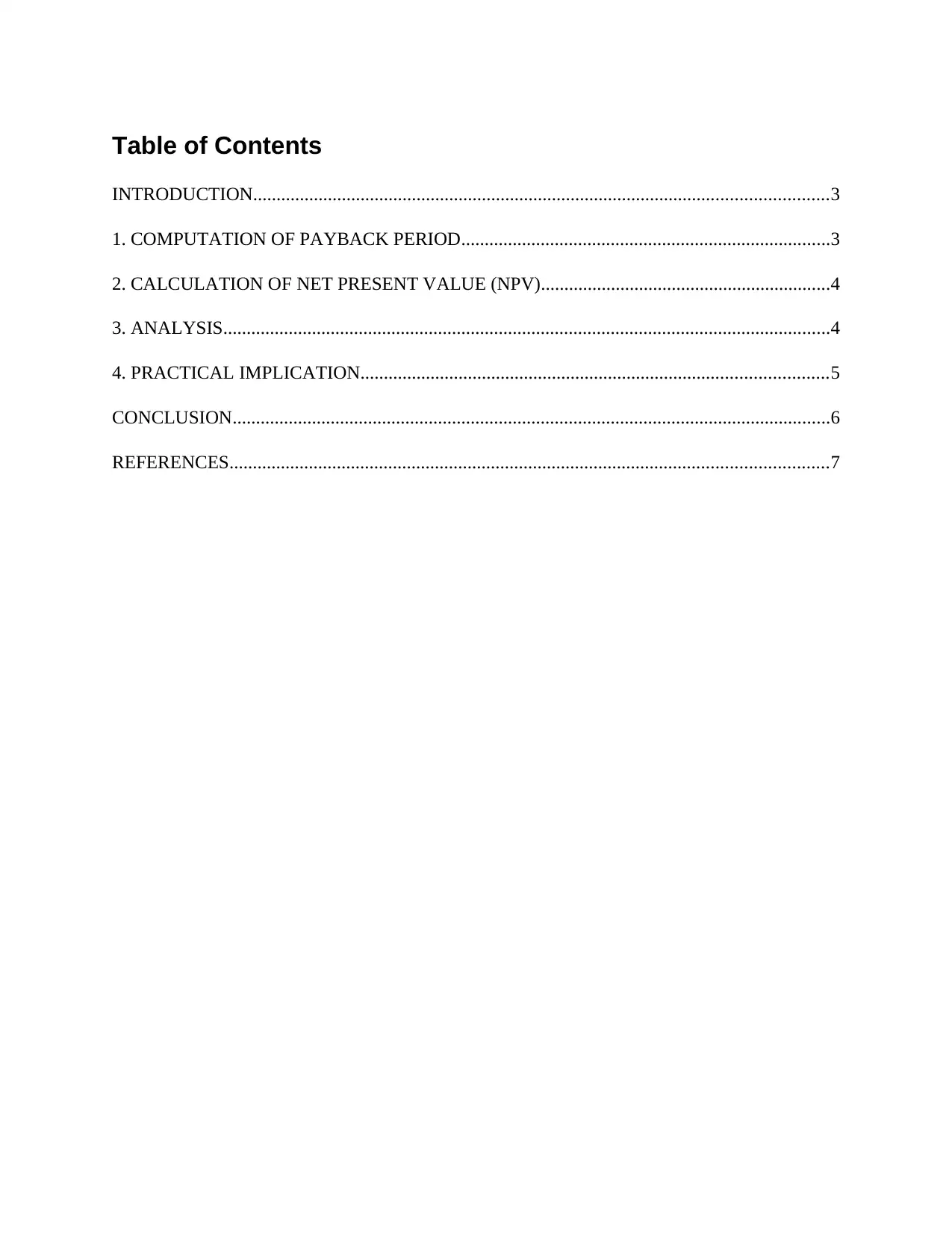
Table of Contents
INTRODUCTION...........................................................................................................................3
1. COMPUTATION OF PAYBACK PERIOD...............................................................................3
2. CALCULATION OF NET PRESENT VALUE (NPV)..............................................................4
3. ANALYSIS..................................................................................................................................4
4. PRACTICAL IMPLICATION....................................................................................................5
CONCLUSION................................................................................................................................6
REFERENCES................................................................................................................................7
INTRODUCTION...........................................................................................................................3
1. COMPUTATION OF PAYBACK PERIOD...............................................................................3
2. CALCULATION OF NET PRESENT VALUE (NPV)..............................................................4
3. ANALYSIS..................................................................................................................................4
4. PRACTICAL IMPLICATION....................................................................................................5
CONCLUSION................................................................................................................................6
REFERENCES................................................................................................................................7
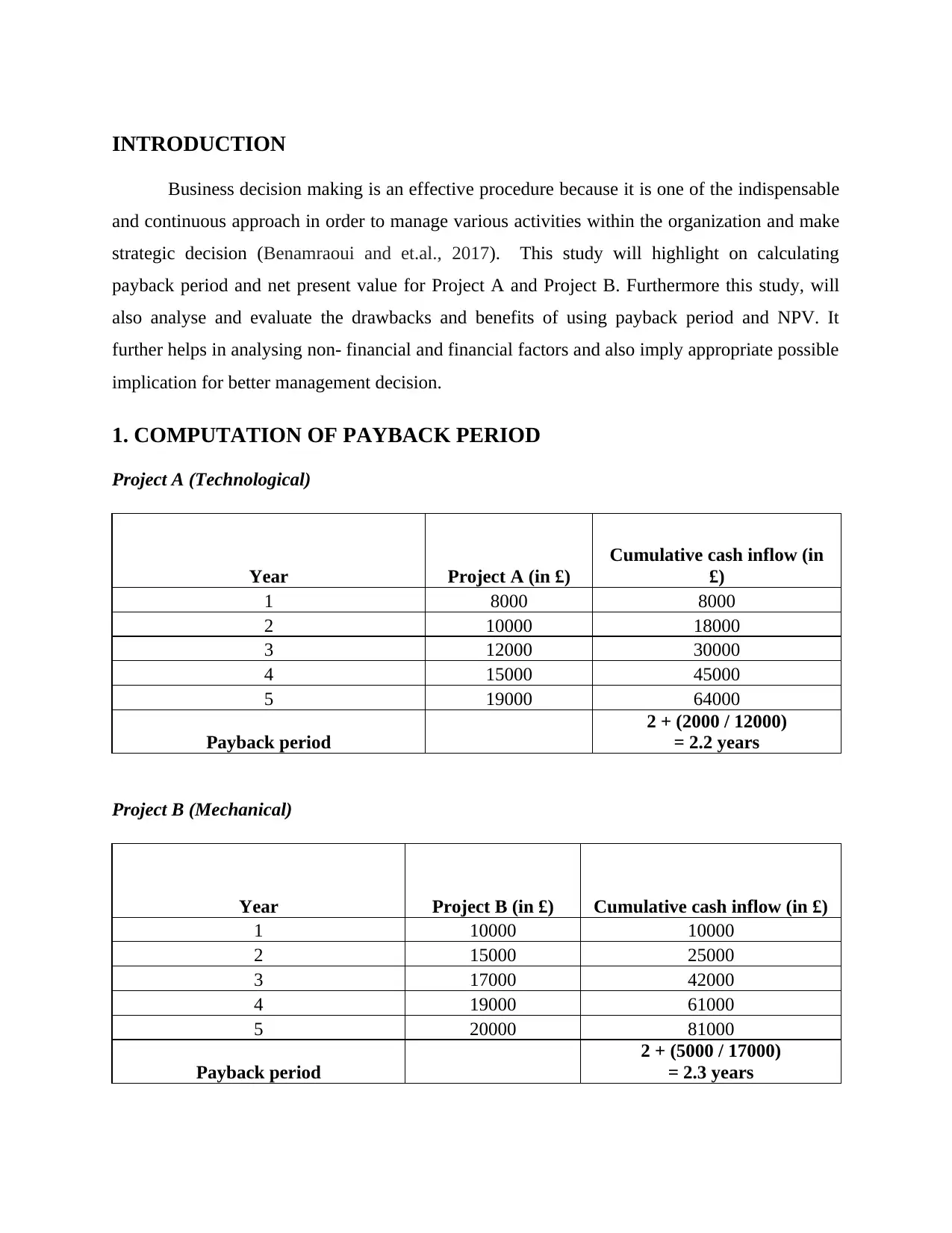
INTRODUCTION
Business decision making is an effective procedure because it is one of the indispensable
and continuous approach in order to manage various activities within the organization and make
strategic decision (Benamraoui and et.al., 2017). This study will highlight on calculating
payback period and net present value for Project A and Project B. Furthermore this study, will
also analyse and evaluate the drawbacks and benefits of using payback period and NPV. It
further helps in analysing non- financial and financial factors and also imply appropriate possible
implication for better management decision.
1. COMPUTATION OF PAYBACK PERIOD
Project A (Technological)
Year Project A (in £)
Cumulative cash inflow (in
£)
1 8000 8000
2 10000 18000
3 12000 30000
4 15000 45000
5 19000 64000
Payback period
2 + (2000 / 12000)
= 2.2 years
Project B (Mechanical)
Year Project B (in £) Cumulative cash inflow (in £)
1 10000 10000
2 15000 25000
3 17000 42000
4 19000 61000
5 20000 81000
Payback period
2 + (5000 / 17000)
= 2.3 years
Business decision making is an effective procedure because it is one of the indispensable
and continuous approach in order to manage various activities within the organization and make
strategic decision (Benamraoui and et.al., 2017). This study will highlight on calculating
payback period and net present value for Project A and Project B. Furthermore this study, will
also analyse and evaluate the drawbacks and benefits of using payback period and NPV. It
further helps in analysing non- financial and financial factors and also imply appropriate possible
implication for better management decision.
1. COMPUTATION OF PAYBACK PERIOD
Project A (Technological)
Year Project A (in £)
Cumulative cash inflow (in
£)
1 8000 8000
2 10000 18000
3 12000 30000
4 15000 45000
5 19000 64000
Payback period
2 + (2000 / 12000)
= 2.2 years
Project B (Mechanical)
Year Project B (in £) Cumulative cash inflow (in £)
1 10000 10000
2 15000 25000
3 17000 42000
4 19000 61000
5 20000 81000
Payback period
2 + (5000 / 17000)
= 2.3 years
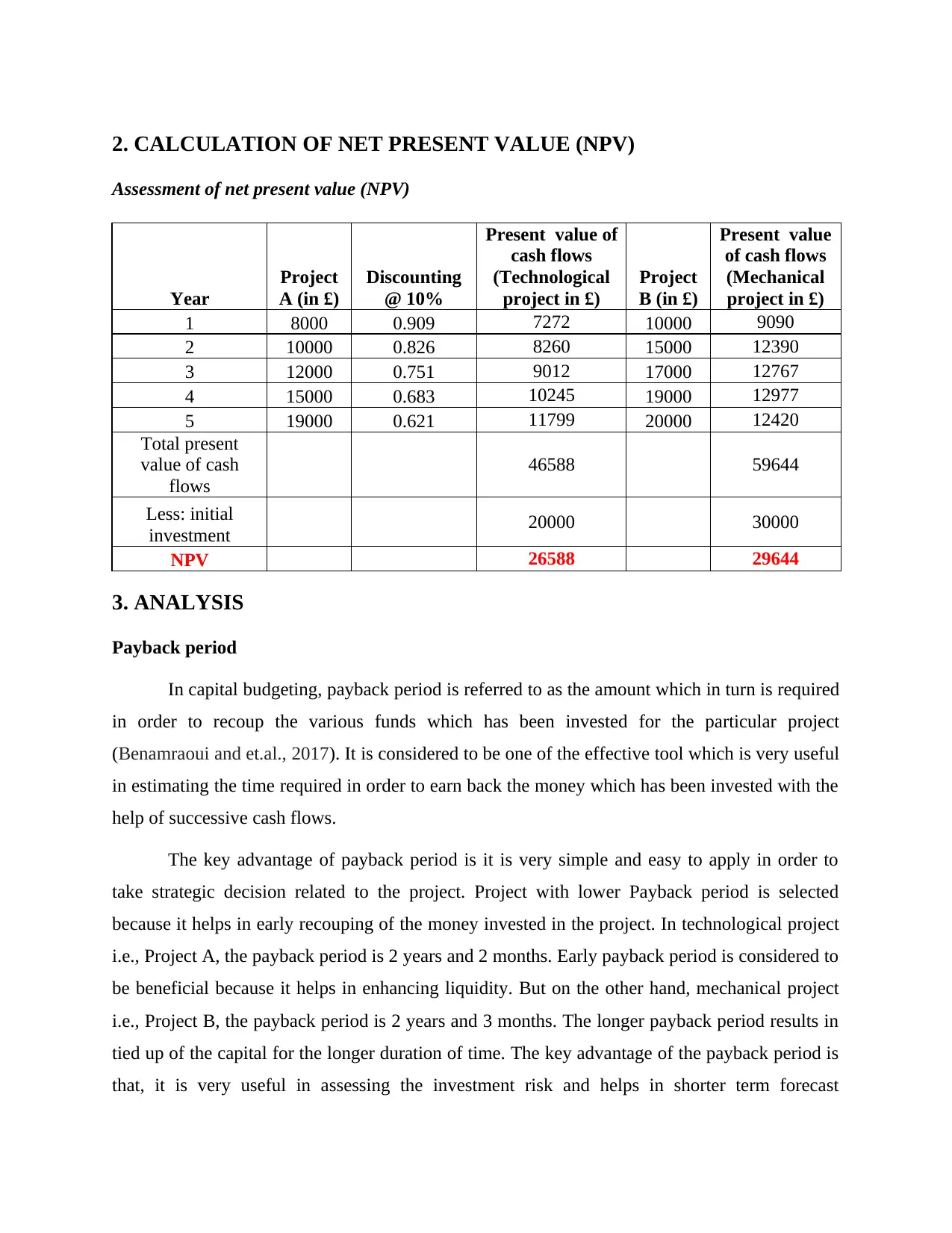
2. CALCULATION OF NET PRESENT VALUE (NPV)
Assessment of net present value (NPV)
Year
Project
A (in £)
Discounting
@ 10%
Present value of
cash flows
(Technological
project in £)
Project
B (in £)
Present value
of cash flows
(Mechanical
project in £)
1 8000 0.909 7272 10000 9090
2 10000 0.826 8260 15000 12390
3 12000 0.751 9012 17000 12767
4 15000 0.683 10245 19000 12977
5 19000 0.621 11799 20000 12420
Total present
value of cash
flows
46588 59644
Less: initial
investment 20000 30000
NPV 26588 29644
3. ANALYSIS
Payback period
In capital budgeting, payback period is referred to as the amount which in turn is required
in order to recoup the various funds which has been invested for the particular project
(Benamraoui and et.al., 2017). It is considered to be one of the effective tool which is very useful
in estimating the time required in order to earn back the money which has been invested with the
help of successive cash flows.
The key advantage of payback period is it is very simple and easy to apply in order to
take strategic decision related to the project. Project with lower Payback period is selected
because it helps in early recouping of the money invested in the project. In technological project
i.e., Project A, the payback period is 2 years and 2 months. Early payback period is considered to
be beneficial because it helps in enhancing liquidity. But on the other hand, mechanical project
i.e., Project B, the payback period is 2 years and 3 months. The longer payback period results in
tied up of the capital for the longer duration of time. The key advantage of the payback period is
that, it is very useful in assessing the investment risk and helps in shorter term forecast
Assessment of net present value (NPV)
Year
Project
A (in £)
Discounting
@ 10%
Present value of
cash flows
(Technological
project in £)
Project
B (in £)
Present value
of cash flows
(Mechanical
project in £)
1 8000 0.909 7272 10000 9090
2 10000 0.826 8260 15000 12390
3 12000 0.751 9012 17000 12767
4 15000 0.683 10245 19000 12977
5 19000 0.621 11799 20000 12420
Total present
value of cash
flows
46588 59644
Less: initial
investment 20000 30000
NPV 26588 29644
3. ANALYSIS
Payback period
In capital budgeting, payback period is referred to as the amount which in turn is required
in order to recoup the various funds which has been invested for the particular project
(Benamraoui and et.al., 2017). It is considered to be one of the effective tool which is very useful
in estimating the time required in order to earn back the money which has been invested with the
help of successive cash flows.
The key advantage of payback period is it is very simple and easy to apply in order to
take strategic decision related to the project. Project with lower Payback period is selected
because it helps in early recouping of the money invested in the project. In technological project
i.e., Project A, the payback period is 2 years and 2 months. Early payback period is considered to
be beneficial because it helps in enhancing liquidity. But on the other hand, mechanical project
i.e., Project B, the payback period is 2 years and 3 months. The longer payback period results in
tied up of the capital for the longer duration of time. The key advantage of the payback period is
that, it is very useful in assessing the investment risk and helps in shorter term forecast
Secure Best Marks with AI Grader
Need help grading? Try our AI Grader for instant feedback on your assignments.
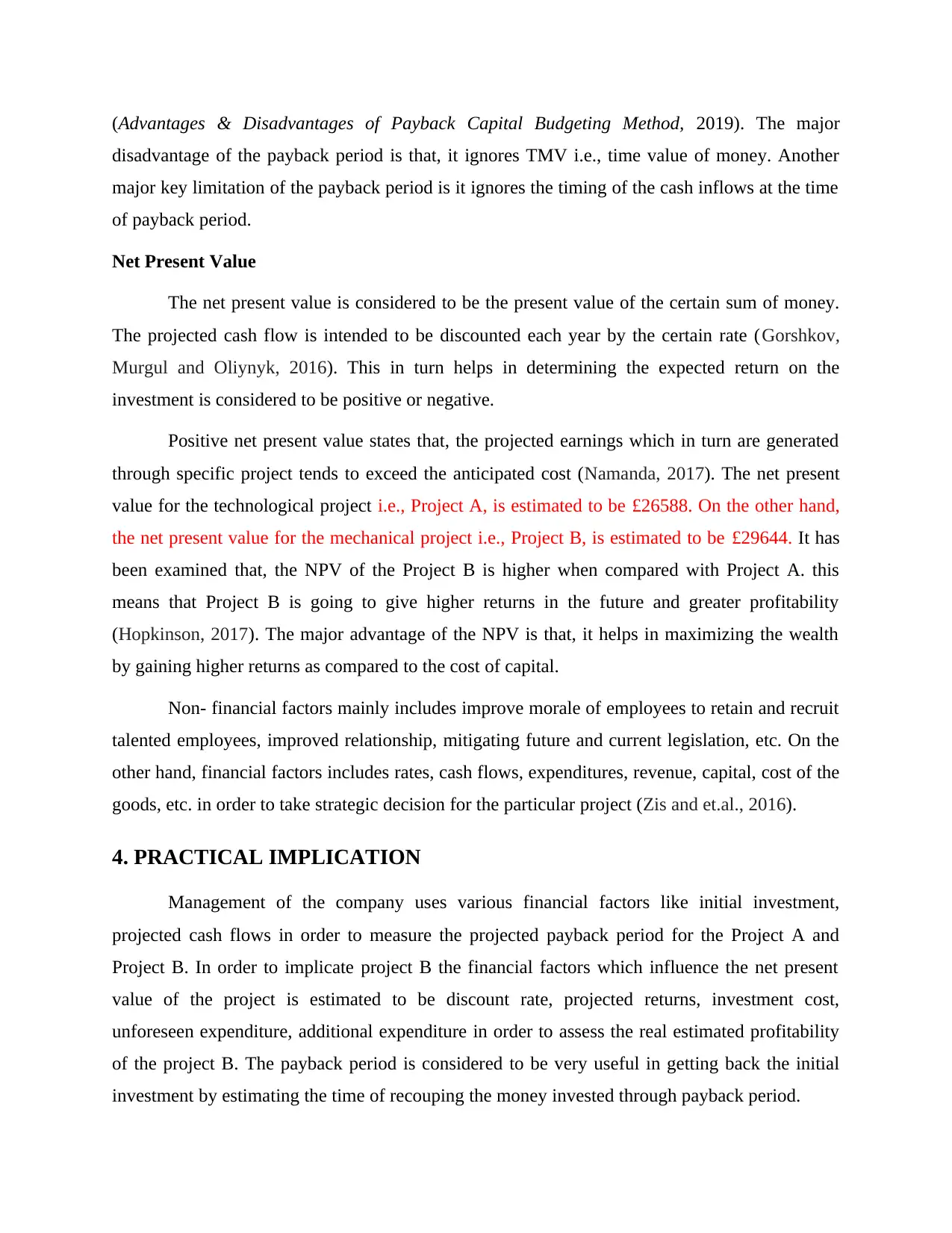
(Advantages & Disadvantages of Payback Capital Budgeting Method, 2019). The major
disadvantage of the payback period is that, it ignores TMV i.e., time value of money. Another
major key limitation of the payback period is it ignores the timing of the cash inflows at the time
of payback period.
Net Present Value
The net present value is considered to be the present value of the certain sum of money.
The projected cash flow is intended to be discounted each year by the certain rate (Gorshkov,
Murgul and Oliynyk, 2016). This in turn helps in determining the expected return on the
investment is considered to be positive or negative.
Positive net present value states that, the projected earnings which in turn are generated
through specific project tends to exceed the anticipated cost (Namanda, 2017). The net present
value for the technological project i.e., Project A, is estimated to be £26588. On the other hand,
the net present value for the mechanical project i.e., Project B, is estimated to be £29644. It has
been examined that, the NPV of the Project B is higher when compared with Project A. this
means that Project B is going to give higher returns in the future and greater profitability
(Hopkinson, 2017). The major advantage of the NPV is that, it helps in maximizing the wealth
by gaining higher returns as compared to the cost of capital.
Non- financial factors mainly includes improve morale of employees to retain and recruit
talented employees, improved relationship, mitigating future and current legislation, etc. On the
other hand, financial factors includes rates, cash flows, expenditures, revenue, capital, cost of the
goods, etc. in order to take strategic decision for the particular project (Zis and et.al., 2016).
4. PRACTICAL IMPLICATION
Management of the company uses various financial factors like initial investment,
projected cash flows in order to measure the projected payback period for the Project A and
Project B. In order to implicate project B the financial factors which influence the net present
value of the project is estimated to be discount rate, projected returns, investment cost,
unforeseen expenditure, additional expenditure in order to assess the real estimated profitability
of the project B. The payback period is considered to be very useful in getting back the initial
investment by estimating the time of recouping the money invested through payback period.
disadvantage of the payback period is that, it ignores TMV i.e., time value of money. Another
major key limitation of the payback period is it ignores the timing of the cash inflows at the time
of payback period.
Net Present Value
The net present value is considered to be the present value of the certain sum of money.
The projected cash flow is intended to be discounted each year by the certain rate (Gorshkov,
Murgul and Oliynyk, 2016). This in turn helps in determining the expected return on the
investment is considered to be positive or negative.
Positive net present value states that, the projected earnings which in turn are generated
through specific project tends to exceed the anticipated cost (Namanda, 2017). The net present
value for the technological project i.e., Project A, is estimated to be £26588. On the other hand,
the net present value for the mechanical project i.e., Project B, is estimated to be £29644. It has
been examined that, the NPV of the Project B is higher when compared with Project A. this
means that Project B is going to give higher returns in the future and greater profitability
(Hopkinson, 2017). The major advantage of the NPV is that, it helps in maximizing the wealth
by gaining higher returns as compared to the cost of capital.
Non- financial factors mainly includes improve morale of employees to retain and recruit
talented employees, improved relationship, mitigating future and current legislation, etc. On the
other hand, financial factors includes rates, cash flows, expenditures, revenue, capital, cost of the
goods, etc. in order to take strategic decision for the particular project (Zis and et.al., 2016).
4. PRACTICAL IMPLICATION
Management of the company uses various financial factors like initial investment,
projected cash flows in order to measure the projected payback period for the Project A and
Project B. In order to implicate project B the financial factors which influence the net present
value of the project is estimated to be discount rate, projected returns, investment cost,
unforeseen expenditure, additional expenditure in order to assess the real estimated profitability
of the project B. The payback period is considered to be very useful in getting back the initial
investment by estimating the time of recouping the money invested through payback period.
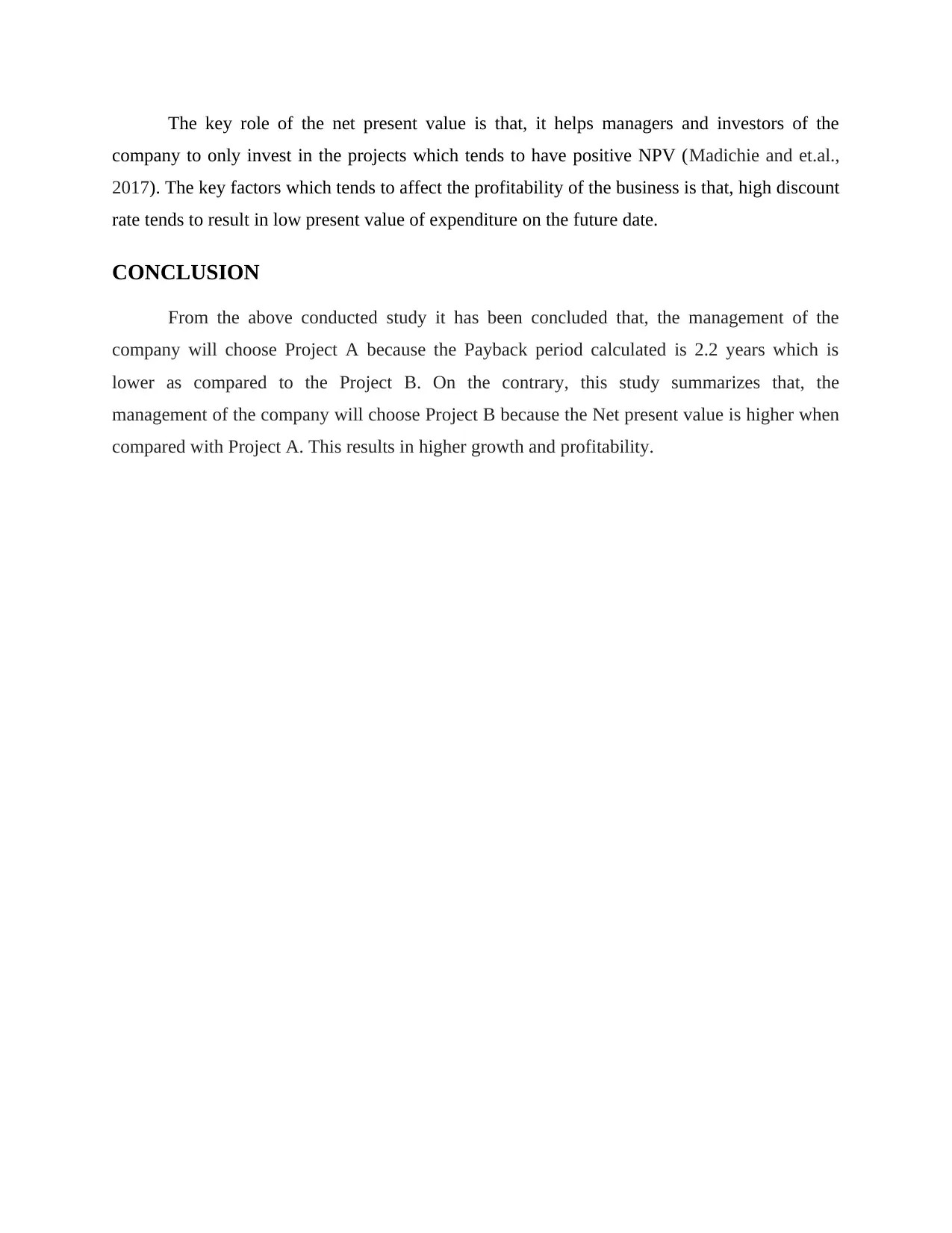
The key role of the net present value is that, it helps managers and investors of the
company to only invest in the projects which tends to have positive NPV (Madichie and et.al.,
2017). The key factors which tends to affect the profitability of the business is that, high discount
rate tends to result in low present value of expenditure on the future date.
CONCLUSION
From the above conducted study it has been concluded that, the management of the
company will choose Project A because the Payback period calculated is 2.2 years which is
lower as compared to the Project B. On the contrary, this study summarizes that, the
management of the company will choose Project B because the Net present value is higher when
compared with Project A. This results in higher growth and profitability.
company to only invest in the projects which tends to have positive NPV (Madichie and et.al.,
2017). The key factors which tends to affect the profitability of the business is that, high discount
rate tends to result in low present value of expenditure on the future date.
CONCLUSION
From the above conducted study it has been concluded that, the management of the
company will choose Project A because the Payback period calculated is 2.2 years which is
lower as compared to the Project B. On the contrary, this study summarizes that, the
management of the company will choose Project B because the Net present value is higher when
compared with Project A. This results in higher growth and profitability.
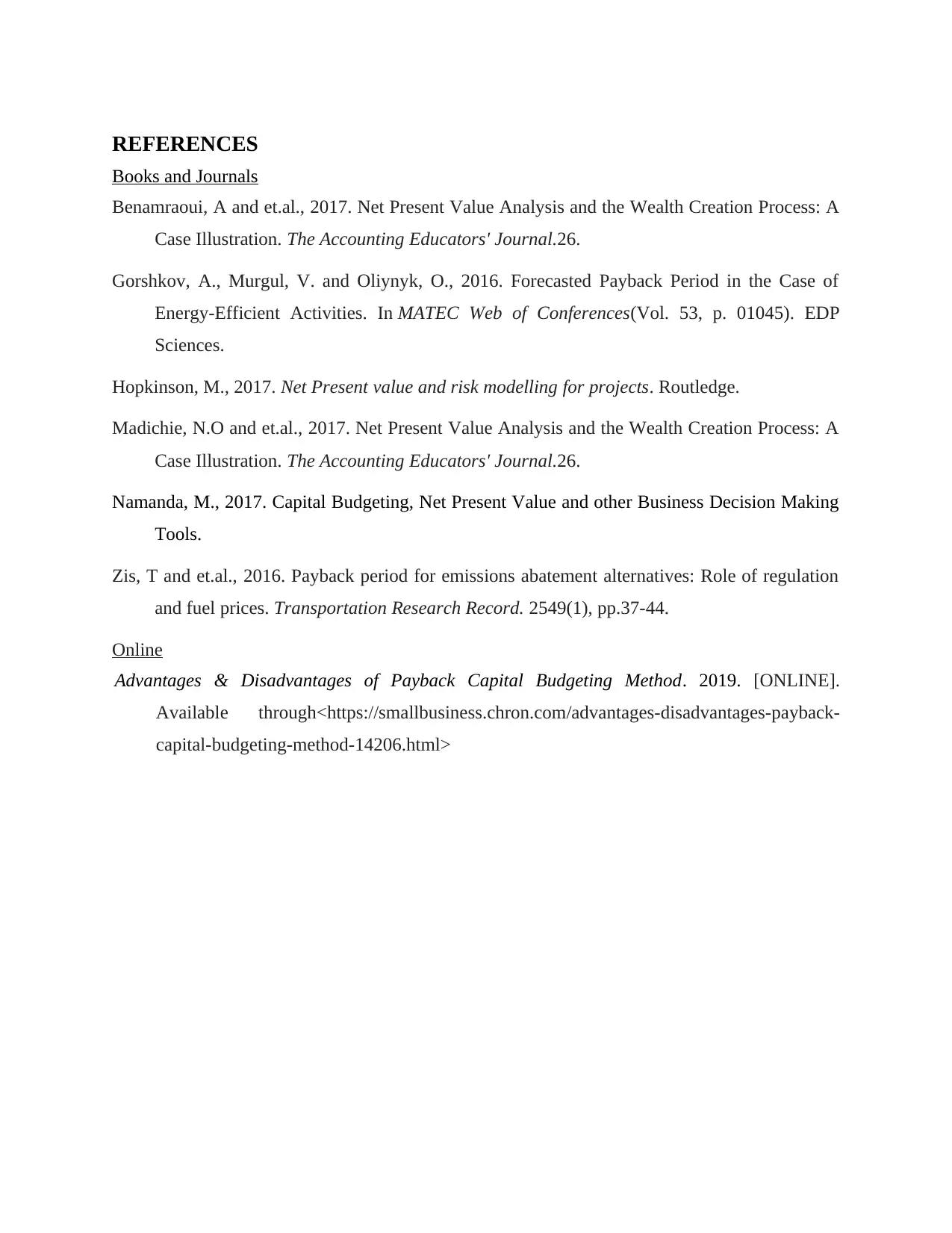
REFERENCES
Books and Journals
Benamraoui, A and et.al., 2017. Net Present Value Analysis and the Wealth Creation Process: A
Case Illustration. The Accounting Educators' Journal.26.
Gorshkov, A., Murgul, V. and Oliynyk, O., 2016. Forecasted Payback Period in the Case of
Energy-Efficient Activities. In MATEC Web of Conferences(Vol. 53, p. 01045). EDP
Sciences.
Hopkinson, M., 2017. Net Present value and risk modelling for projects. Routledge.
Madichie, N.O and et.al., 2017. Net Present Value Analysis and the Wealth Creation Process: A
Case Illustration. The Accounting Educators' Journal.26.
Namanda, M., 2017. Capital Budgeting, Net Present Value and other Business Decision Making
Tools.
Zis, T and et.al., 2016. Payback period for emissions abatement alternatives: Role of regulation
and fuel prices. Transportation Research Record. 2549(1), pp.37-44.
Online
Advantages & Disadvantages of Payback Capital Budgeting Method. 2019. [ONLINE].
Available through<https://smallbusiness.chron.com/advantages-disadvantages-payback-
capital-budgeting-method-14206.html>
Books and Journals
Benamraoui, A and et.al., 2017. Net Present Value Analysis and the Wealth Creation Process: A
Case Illustration. The Accounting Educators' Journal.26.
Gorshkov, A., Murgul, V. and Oliynyk, O., 2016. Forecasted Payback Period in the Case of
Energy-Efficient Activities. In MATEC Web of Conferences(Vol. 53, p. 01045). EDP
Sciences.
Hopkinson, M., 2017. Net Present value and risk modelling for projects. Routledge.
Madichie, N.O and et.al., 2017. Net Present Value Analysis and the Wealth Creation Process: A
Case Illustration. The Accounting Educators' Journal.26.
Namanda, M., 2017. Capital Budgeting, Net Present Value and other Business Decision Making
Tools.
Zis, T and et.al., 2016. Payback period for emissions abatement alternatives: Role of regulation
and fuel prices. Transportation Research Record. 2549(1), pp.37-44.
Online
Advantages & Disadvantages of Payback Capital Budgeting Method. 2019. [ONLINE].
Available through<https://smallbusiness.chron.com/advantages-disadvantages-payback-
capital-budgeting-method-14206.html>
1 out of 7
Related Documents
Your All-in-One AI-Powered Toolkit for Academic Success.
+13062052269
info@desklib.com
Available 24*7 on WhatsApp / Email
![[object Object]](/_next/static/media/star-bottom.7253800d.svg)
Unlock your academic potential
© 2024 | Zucol Services PVT LTD | All rights reserved.





